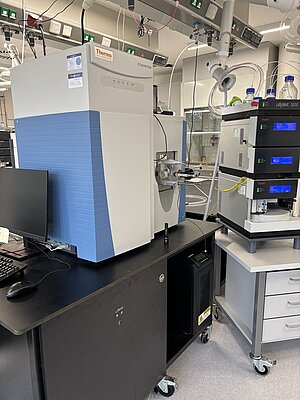bioMS technology platform
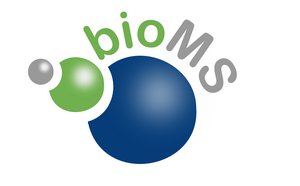
bioMS is a central technology platform in which high-performance MS systems are operated in the laboratories of the Chair of Biochemistry II under the direction of Prof. Bettina Warscheid. It supports the efficient use and networking of existing expertise in mass spectrometric analysis, bioinformatics and researchers in Würzburg and the surrounding area.
To ensure smooth operation and rapid processing of all measurements, users must accept the terms of use. Subsequently, a sample analysis or the use of the platform can be requested by e-mail to bc2-wuebioms@uni-wuerzburg.de. If samples are already available, please enclose the completed sample information sheet.
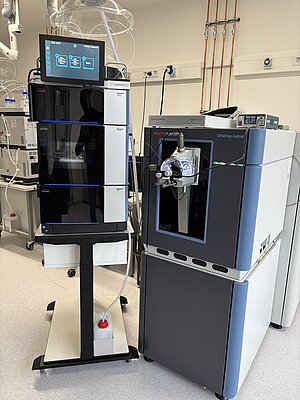
Orbitrap Astral
Mass range: 40 to 6,000 m/z
Resolution: Up to 480,000 at 200 m/z (Orbitrap analyzer)
Mass accuracy: < 3 ppm RMS (external calibration), < 1 ppm RMS (internal calibration)
Scan rates: Up to 200 Hz (Astral analyzer), up to 40 Hz (Orbitrap analyzer)
Dynamic range: > 5,000 in a single scan
The Orbitrap Astral mass spectrometer combines high sensitivity, deep proteome coverage and fast throughput. With its innovative combination of quadrupole mass filter, Orbitrap analyzer and Astral analyzer, it delivers high-resolution, accurately mass calibrated data with outstanding sensitivity and dynamic range. With its high MS/MS acquisition rate of up to 200 Hz and the capability for data independent acquisition (DIA) and tandem mass tag (TMT) quantification
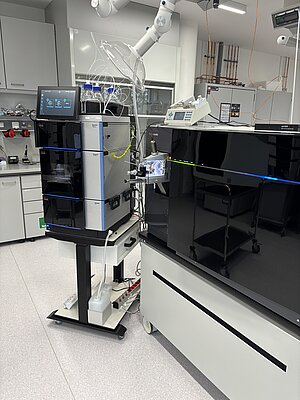
Orbitrap Ascend Tribrid
Mass Range: 40 to 2,000 m/z (expandable to 16,000 m/z with HMRn+ option)
Resolution: Up to 480,000 at 200 m/z
Mass Accuracy: < 3 ppm RMS (external calibration), < 1 ppm RMS (internal calibration)
Scan Rates: Up to 45 Hz (Orbitrap Analyzer), up to 50 Hz (Ion Trap Analyzer)
Dynamic Range: > 5,000 in a single Orbitrap scan
The Orbitrap Ascend Tribrid mass spectrometer from Thermo Scientific sets new standards in proteomics, biopharma analytics, and structural biology. Thanks to its unique Tribrid architecture, it combines a quadrupole mass filter, a linear dual-pressure ion trap, and an Orbitrap analyzer to ensure maximum flexibility and performance. With its highly sensitive Active Ion Management (AIM+) technology, the instrument optimizes ion transmission and reduces interference signals for improved quantification. The Auto-Ready Ion Source allows for fully automated calibration without manual adjustments. The system supports numerous fragmentation techniques, including HCD, CID, ETD, EThcD, and ETciD, making it ideal for comprehensive proteome studies, small molecule analyses, and structural investigations of protein complexes. With the TurboTMT Mode and the Real-Time Search Function for TMT-based quantification, the Orbitrap Ascend achieves unmatched accuracy and proteome depth—from single cells to highly complex biological samples.
Q Exactive Plus
Mass range: 50 to 6,000 m/z (mass over charge)
Resolution: up to 140,000 at 200 m/z, maximum 280,000
Ion fragmentation : HCD (Higher-Energy Collisional Dissociation)
Mass accuracy : < 3 ppm RMS (root mean square) external calibration, < 1 ppm RMS internal calibration
High scanning speed (12 Hz, 17,500 resolution)
Multiplexing (up to 10 precursors/scan) and targeted proteomics (SIM/PRM)
The Q Exactive Plus is a benchtop unit that is coupled with the Ultimate 3000 RSLC system for LC/MS applications. The Proxeon source with a steel emitter is used for electrospray ionisation. Ionised peptides enter the Q Exactive Plus through a heated transfer capillary and an S-lens and focus the ion stream. The ion stream is then directed to an advanced quadrupole mass filter and selected ions are collected and stored in a C-trap. The C-trap transfers ions to either the Orbitrap mass analyser or the HCD cell for ion fragmentation, followed by mass analysis in the Orbitrap. The Q Exactive enables the monitoring of selected ions (SIM) and the monitoring of parallel reactions (PRM).
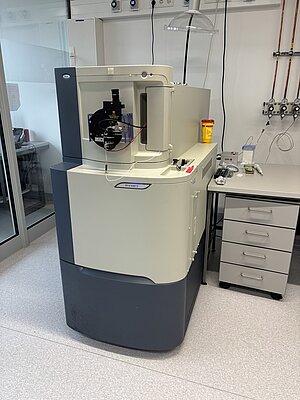
Synapt G1 HDMS Q-TOF
Mass range: 400 to 32000 m/z (Qudrupolation for MS/MS up to m/z 32000)
Application: Detection of high masses and intact non-covalent protein complexes
Ion fragmentation: collision-induced dissociation with argon or xenon gas
Ion mobility separation: travelling wave tube for separation by collision cross-section
The instrument uses electrospray to transfer proteins intact and in their folded state as well as non-covalent protein complexes from an aqueous buffer solution into the gas phase without dissociation or fragmentation. This mass spectrometric technique is known as ‘Native MS’ and enables the investigation of the binding affinity and stoichiometry of protein-protein or protein-ligand complexes as well as the determination of the precise molecular masses of the individual components of a complex system. In recent years, Native MS has become an important complementary method to existing structural biological analysis tools. In addition, Native MS has been successfully combined with Ion Mobility Spectrometry (IMS) in the gas phase. In this technique, ions are passed in packets through a drift tube filled with nitrogen. As larger ions are slowed down more during collisions than smaller ones, a drift time spectrum can be recorded. By comparing the drift times of proteins with known collision cross-sections (CCS), the CCS of an analyte can be estimated. This makes it possible to identify conformational changes induced by ligand binding or mutations and to monitor the unfolding of proteins during stepwise collision activation.
High-performance liquid chromatography (HPLC)
We have several differently configured Dionex/Thermo Ultimate 3000 HPLC systems in our laboratory. The offline systems (i.e. not directly coupled to a mass spectrometer) offer flow rates ranging from microlitres to nanolitres. In combination with various analytical columns, these systems are used for reversed-phase (RP) or size-exclusion chromatography of intact proteins or peptides after enzymatic digestion. The LC systems are also equipped with a sampler module that enables the collection of chromatographic fractions.
The online HPLC systems operate at flow rates in the nanolitre range, which are required for stable electrospray ionisation. These systems have a dual valve system that allows parallel loading of the sample onto one of the two precolumns while the other precolumn is simultaneously washed and conditioned.
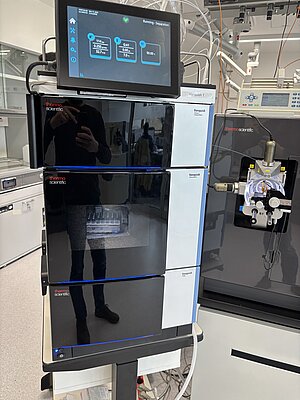
Vanquish Neo UHPLC
Flow Rates: 1 nL/min – 100 µL/min (recommended: 100 nL/min – 100 µL/min)
Maximum Pressure: Up to 1,500 bar
Gradient Volume: <0.5 µL in nano direct injection configuration
Sample Introduction: Direct injection or trap-and-elute with forward or reverse elution
MS Coupling: Compatible with mass spectrometry systems
The Vanquish Neo UHPLC system is designed for nano-LC-MS applications, offering a wide flow rate range and high-pressure stability. Active flow control ensures precise retention times and stable gradients. An automated rinsing system reduces carryover, while SmartInject technology minimizes pressure fluctuations to extend column lifespan. The system supports various injection modes, including direct injections and trap-and-elute strategies, and enables the processing of small sample volumes with Vial Bottom Detection. Featuring an intuitive user interface (Vanquish User Interface, VUI), the system provides direct control options, system monitoring, and maintenance functions.

UltiMate 3000 RSLCnano
Flow Rates: 50 nL/min – 1,000 nL/min
Maximum Pressure: Up to 900 bar (ProFlow Flowmeter)
Column Compatibility: Nano columns (75 µm I.D.)
Sample Introduction: Direct injection or pre-concentration with trapping columns
MS Coupling: Optimized for coupling with Thermo Scientific mass spectrometers
The UltiMate 3000 RSLCnano from Thermo Scientific is an advanced UHPLC system for demanding proteomic analyses. It enables precise and reproducible separations with extremely low flow rates and high sensitivity. Thanks to ProFlow technology, the system offers precise flow control, maximizing gradient stability and reproducibility. The nanoViper fittings ensure dead-volume-free connections for optimal chromatographic performance. The system is compatible with a variety of trapping and separation columns, allowing for both direct injections and sample pre-concentration.
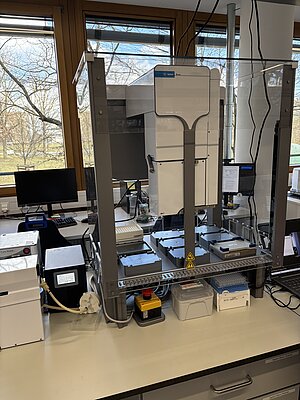
Agilent Bravo
Platform Capacity: 9 positions for 96-, 384-, and 1536-well microplates
Pipetting Heads: Interchangeable disposable tip and AssayMAP heads
Injection Volume: 0.05 – 250 µL (depending on head configuration)
Gripper Function: For automated plate movement
Control: VWorks software for protocol creation and device control
The Agilent Bravo Platform is a versatile liquid handling system designed for high-throughput proteomics applications. With nine positions on the work deck, the Bravo platform offers flexibility for various pipetting tasks. The interchangeable liquid handling heads support both disposable tips for standard applications and the AssayMAP head for cartridge-based assays. The VWorks software enables precise platform control, including Teachpoint calibration for reproducible pipetting processes. A gripper allows for automated movement of microplates within the deck. The Bravo Platform is suitable for a wide range of laboratory applications, from sample preparation to high-throughput screening analysis.




